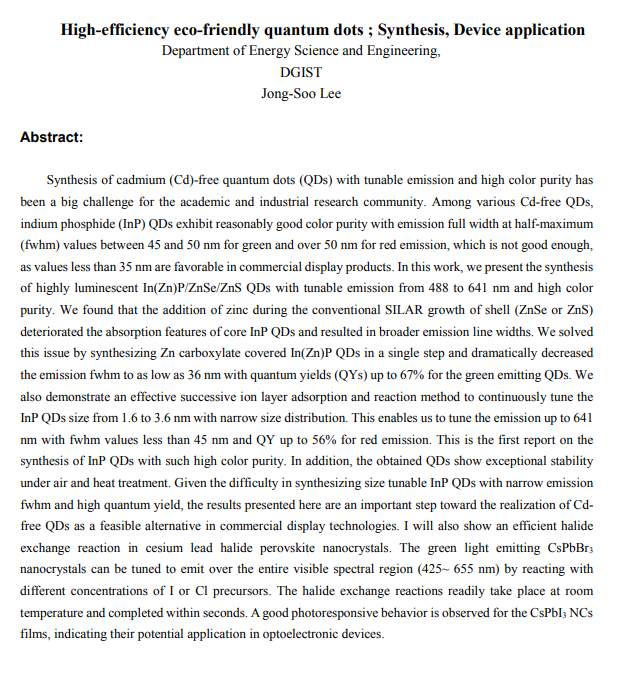Date, Place: 3월
15일
(목
) 오후
4시
, 화학관
400호
Speaker: Prof. Jong-Soo Lee (DGIST)
Subject: High-efficiency eco-friendly quantum dots ; Synthesis, Device application
Abstract
Synthesis of cadmium (Cd)-free quantum dots (QDs) with tunable emission and high color purity has
been a big challenge for the academic and industrial research community. Among various Cd-free QDs,
indium phosphide (InP) QDs exhibit reasonably good color purity with emission full width at half-maximum
(fwhm) values between 45 and 50 nm for green and over 50 nm for red emission, which is not good enough,
as values less than 35 nm are favorable in commercial display products. In this work, we present the synthesis
of highly luminescent In(Zn)P/ZnSe/ZnS QDs with tunable emission from 488 to 641 nm and high color
purity. We found that the addition of zinc during the conventional SILAR growth of shell (ZnSe or ZnS)
deteriorated the absorption features of core InP QDs and resulted in broader emission line widths. We solved
this issue by synthesizing Zn carboxylate covered In(Zn)P QDs in a single step and dramatically decreased
the emission fwhm to as low as 36 nm with quantum yields (QYs) up to 67% for the green emitting QDs. We
also demonstrate an effective successive ion layer adsorption and reaction method to continuously tune the
InP QDs size from 1.6 to 3.6 nm with narrow size distribution. This enables us to tune the emission up to 641
nm with fwhm values less than 45 nm and QY up to 56% for red emission. This is the first report on the
synthesis of InP QDs with such high color purity. In addition, the obtained QDs show exceptional stability
under air and heat treatment. Given the difficulty in synthesizing size tunable InP QDs with narrow emission
fwhm and high quantum yield, the results presented here are an important step toward the realization of Cdfree
QDs as a feasible alternative in commercial display technologies. I will also show an efficient halide
exchange reaction in cesium lead halide perovskite nanocrystals. The green light emitting CsPbBr3
nanocrystals can be tuned to emit over the entire visible spectral region (425~ 655 nm) by reacting with
different concentrations of I or Cl precursors. The halide exchange reactions readily take place at room
temperature and completed within seconds. A good photoresponsive behavior is observed for the CsPbI3 NCs
films, indicating their potential application in optoelectronic devices.


